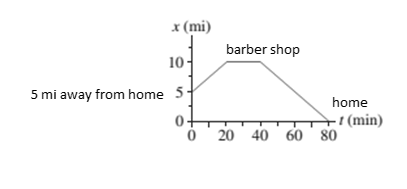
Concept explainers
For Questions 1 through 3, interpret the position graph given in each figure by writing a very short “story” of what is happening. Be creative! Have characters and situations! Simply saying that “a car moves 100 meters to the right” doesn’t qualify as a story. Your stories should make specific reference to information you obtain from the graph, such as distance moved or time elapsed.
Short story which interprets the graph.
Explanation of Solution
Given:
Distance versus time graph.
Paul is 5 mi away from the home at a car shop. He traveled to the barber shop and covered the distance of 5 mi, in further 20 mins he reached a barber shop, where he had a haircut in 20 min. Then, he traveled back home with the same speed and covered 10mi in 40 mins.
Consider the figure of the movement indicating the movement of Paul,

Figure.1
Conclusion:
This figure indicates the movement of Paul, and variation in distance with respect to time.
Want to see more full solutions like this?
Chapter 2 Solutions
Physics for Scientists and Engineers: A Strategic Approach with Modern Physics (Chs 1-42) Plus Mastering Physics with Pearson eText -- Access Card Package (4th Edition)
Additional Science Textbook Solutions
Anatomy & Physiology (6th Edition)
Human Biology: Concepts and Current Issues (8th Edition)
Cosmic Perspective Fundamentals
Campbell Essential Biology with Physiology (5th Edition)
Genetic Analysis: An Integrated Approach (3rd Edition)
Human Physiology: An Integrated Approach (8th Edition)
- Scalars and Vectors A weather forecast states the temperature is predicted to be 5Cthe following day. Is this temperature a vector or a scalar quantity? Explain.arrow_forwardAcceleration a has the dimensions of length per time squared, speed v has the dimensions of length per time, and radius r has the dimension of length. Which of the following expressions may be correct? Explain your answer in each case. a. a = vr b. a = v/r c. a = v2/r d. a = v/r2arrow_forwardA walker sees a rock fall from the top of a steep cliff and notices that it takes 1.5 seconds for the rock to fall the final third ( or 1/3) of the way. a) What is the height of the cliff in meters? b) In part (a) you get two roots to a quadratic equation and use one of them for your answer. What does the second root represent?arrow_forward
- If the distance dd (in meters) traveled by an object in time tt (in seconds) is given by the formula d=A+Bt2d=A+Bt2, the SI units of AA and BB must be meters for both AA and BB. m/sm/s for AA and m/s2m/s2 for BB. meters for AA and m/s2m/s2 for BB. m/s2m/s2 for both AA and BB.arrow_forwardcan you help with question B.arrow_forwardPls help ASAParrow_forward
- USE THE CORRECT NUMBER OF SIGNIFICANT FIGURES IN THE ANSWER!arrow_forwardPlease answer the following question(s): 1. The speed of a boat in still water is vá. A river flows with a speed of v₁. The boat travels distance of 19 miles downstream in a river in 1 hour. However, the return journey takes 2 hours. Calculate the vand v₁. Hint: Velocity=displacement/time. Displacement can be positive of neagtive depending on the direction. You will first need to set up the equations by taking into account the resultant velocity of the boat in flowing water. Consider the direction the river is flowing to be positive. Set up two equations, one for the downstream journey and one for the upstream journey, in terms of "v" and "v": Do v" and "v, add or substract downstream to give the resultant downstream velocity? Do v" and "v, add or substract upstream togive the resultant upstream velocity? Use the upstream direction as negative. The resultant upstream velocity should be negative. vb vb Downstream positive Vr Upstream negative Vrarrow_forwardCan you solve this? With draw an illustration of the given situation below then solve the problem.arrow_forward
- Given the quantities a=3.4m, b=8.8s, c=75m/s, what is the value of the quantity d=a^3/cb^2arrow_forwardQUESTION 1 Supply all missing information with the correct numerical values. Do not include the units. Round off all answers to two decimal places. Do not forget the negative sign (-) if needed. Pedro is driving a motorcycle along Espana boulevard. His position X (in meters) at any given time t is given by x(t) = 1.124t2 +6.022. Pedro's initial position is X= m. His position at ten seconds is X= 118.42 m. His speed at ten seconds is V= m/s. His acceleration at ten seconds is a = m/s?. Marites is also driving her motorcycle along Espana. Her position function is of the form X(t) = Ct. What is the coefficient C if her acceleration at ten seconds is 2.04 m/s? C= 20.4 m/s4arrow_forwardGeorge walks to a friend’s house. He walks 750 meters North, then realizes he walked too far. He turns around and walks 250 meters South. The entire walk takes him 13 seconds. What is his velocity in meters per second? Also, is the acceleration due to gravity negative or positive or it depends? I'm really confused. Please help and explain in an easy to understand.arrow_forward
 Physics for Scientists and Engineers with Modern ...PhysicsISBN:9781337553292Author:Raymond A. Serway, John W. JewettPublisher:Cengage Learning
Physics for Scientists and Engineers with Modern ...PhysicsISBN:9781337553292Author:Raymond A. Serway, John W. JewettPublisher:Cengage Learning Principles of Physics: A Calculus-Based TextPhysicsISBN:9781133104261Author:Raymond A. Serway, John W. JewettPublisher:Cengage Learning
Principles of Physics: A Calculus-Based TextPhysicsISBN:9781133104261Author:Raymond A. Serway, John W. JewettPublisher:Cengage Learning Physics for Scientists and Engineers: Foundations...PhysicsISBN:9781133939146Author:Katz, Debora M.Publisher:Cengage Learning
Physics for Scientists and Engineers: Foundations...PhysicsISBN:9781133939146Author:Katz, Debora M.Publisher:Cengage Learning University Physics Volume 1PhysicsISBN:9781938168277Author:William Moebs, Samuel J. Ling, Jeff SannyPublisher:OpenStax - Rice University
University Physics Volume 1PhysicsISBN:9781938168277Author:William Moebs, Samuel J. Ling, Jeff SannyPublisher:OpenStax - Rice University Glencoe Physics: Principles and Problems, Student...PhysicsISBN:9780078807213Author:Paul W. ZitzewitzPublisher:Glencoe/McGraw-Hill
Glencoe Physics: Principles and Problems, Student...PhysicsISBN:9780078807213Author:Paul W. ZitzewitzPublisher:Glencoe/McGraw-Hill




